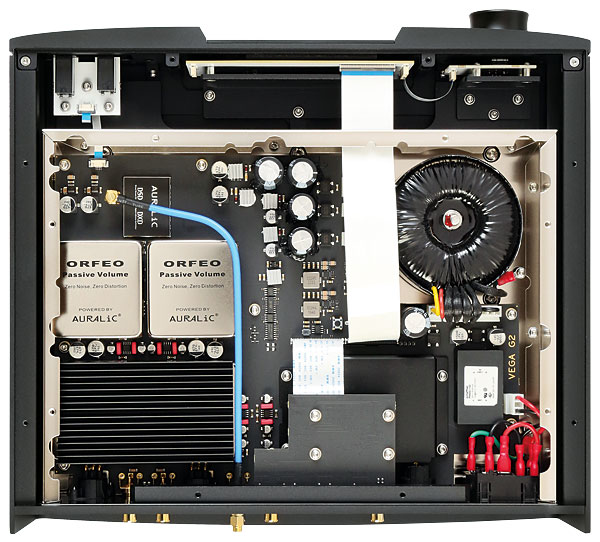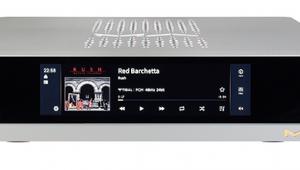Auralic Vega G2.2 Network Attached DAC

 Some ten years after its introduction, the minimalist Vega USB DAC has grown into a fully-fledged streaming solution incorporating a host of proprietary technologies
Some ten years after its introduction, the minimalist Vega USB DAC has grown into a fully-fledged streaming solution incorporating a host of proprietary technologies
The Auralic Vega G2.2, selling for £6899 in best basic black, comes in at just £100 more than the previous G2.1 [HFN Oct '22], and appears to offer evolutionary changes rather than anything truly radical. One thing's for sure, however – the brand has come a long way since it launched its original Vega model, which was basically a USB-input DAC, getting on for a decade ago [HFN Jan '14].
Yes, there are similarities between the first Vega unit and this latest version – the USB-B input is retained, for example, as is the ability to work straight into a power amplifier or active loudspeakers thanks to its built-in preamp. Otherwise the Vega G2.2 is a complete network streaming solution as well as a DAC, able to play music from network storage, such as a NAS device, as well as from a wide range of online streaming services, and all this with file handling all the way up to 384kHz/32-bit PCM and DSD512.
Joining The Rotary Club
The clue to this, if you need one, is the presence of a prominent volume control to the right of the Vega G2.2's solid, sculpted fascia. Well, sort of a volume control because, depending on what you're doing at the time, this rotary encoder will help you navigate the unit's menu system. Nevertheless, to dig really deep – not to mention actually select and play music – you'll need to resort to an external network-connected device.
In addition to its Ethernet port and analogue outputs (on both RCAs and XLRs, plus a 6.35mm headphone output), the Vega G2.2 has coaxial, optical and AES digital inputs; the USB-B port for computer hook-up; an HDMI eARC connection to route audio from a TV or other video device; and even a single set of analogue inputs. Also on HDMI-type connectors are Auralic's Lightning Link ports [HFN Oct '22] for the company's Aries network transports and Leo GX.1 master clock, the latter also being served by a master clock input.

In other words, this new model almost has it all, though some will miss a simple USB-A port for fast and easy playback from local storage devices, and others might perhaps want a Bluetooth/AirPlay input for their phone, or Wi-Fi networking.
Apple Core
A more significant point for many will be the continued absence of an Android version of the Lightning DS app to control the unit. Auralic remains solidly loyal to Apple, although the Vega G2.2 can be set up in detail with a web browser, leaving day-to-day music selection and playback to third-party Open Home control apps running on Android devices. You can also map the unit to the keys on an existing remote handset, but this does sound like something of a faff. Note to Auralic: the latest figures suggest Android has around a 70% share of the smartphone market, while Apple iOS accounts for about 28% – just sayin'...
So why a new version of the Vega? Well, the flip answer is that the Chinese company's engineers just can't leave well alone, but the reality is that this is a further evolution of a long-running design. One of the headline features is what the brand calls its Direct Data Recording (DDR) technology, taking the audio data into system memory on the Tesla G3 platform at the heart of the Vega G2.2, then clocking it out after processing. Like all high-quality DACs, there are two master clocks, one for 44.1kHz-centric data and another for 48kHz-based data.
With all data reclocked and buffered, only the core of the ESS Sabre DAC is used. In what Auralic calls its 'Fusion' DAC, the PLL, digital filter and oversampling functions of the ESS DAC are bypassed in favour of its own DSP-driven solutions.
Preamp Partner
Downstream of the Vega G2.2's digital conversion stage, both the 'Orfeo' preamplifier and its ladder-style volume control are pure analogue designs, bypassable to offer a direct 2V output to feed a preamp, and permitting an AV bypass via that single set of analogue inputs. There's also extensive isolation, both electrical and mechanical: galvanic isolation is employed between the processing platform and the G2.2's audio section, while the outer aluminium casework houses a second nickel/copper box within that provides additional screening. Finally, the chassis is mounted onto a high-mass alloy base suspended on coil-sprung feet.


















































